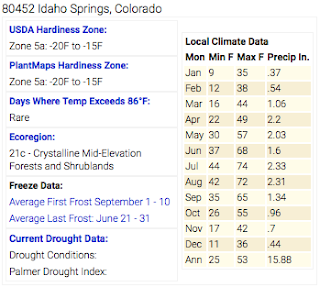For many of us, fall is a fine time to plant many perennials. The soil and air are cooler and sunlight is less intense, so the weather's less stressful for newcomer plants. Competition from weeds isn't likely to be a big problem, either.
In many of our high altitude areas, rainfall becomes more regular, too, which helps provide the moisture the perennials need to start good root growth. Yes, the perennials will soon head into winter dormancy, but fall planting often gives these perennials a head start over their spring-planted counterparts.
In spring, the fall-planted perennials should be raring to
grow, larger and more robust.
Prior to planting, you may
want to confirm your local plant hardiness zones and take a look at your local
site conditions to see if you may have some beneficial (or detrimental)
microclimatic conditions that may allow you to utilize better adapted plants in
these areas.
USDA Plant Hardiness Zone Maps
The 2012 USDA Plant Hardiness Zone Map
is the current standard by which gardeners and growers can determine which
plants are most likely to thrive at a location. The map is based on the average
annual minimum winter temperature, divided into 10-degree F zones.
If your hardiness zone has changed in
this edition of the USDA Plant Hardiness Zone Map (PHZM), it does not mean
you should start pulling plants out of your garden or change what you are
growing. What is thriving in your yard will most likely continue to thrive.
Hardiness zones are based on the average annual extreme minimum temperature during a 30-year period in the past, not the lowest temperature that has ever occurred in the past or might occur in the future. Gardeners should keep that in mind when selecting plants, especially if they choose to "push" their hardiness zone by growing plants not rated for their zone. In addition, although this edition of the USDA PHZM is drawn in the most detailed scale to date, there might still be microclimates that are too small to show up on the map.
Hardiness zones are based on the average annual extreme minimum temperature during a 30-year period in the past, not the lowest temperature that has ever occurred in the past or might occur in the future. Gardeners should keep that in mind when selecting plants, especially if they choose to "push" their hardiness zone by growing plants not rated for their zone. In addition, although this edition of the USDA PHZM is drawn in the most detailed scale to date, there might still be microclimates that are too small to show up on the map.
Plantmaps.com is a relatively new reference
website that contains several interactive maps and tools to assist gardeners,
botanists, farmers and horticulturalists. By entering a ZIP code, users can
find not only the new USDA Plant Hardiness Zone, but also the first and last
frost dates, heat zones, drought conditions and annual climatology for their
area, that the USDA Plant Hardiness Zone website does not provide.
Here’s some examples of plant hardiness
zones and climatic data for Idaho Springs, Evergreen, Bailey, and Conifer, and
you will notice that even those some of these areas have the same plant
hardiness zones, they have different first and last frost dates which you
should account for in your plant selection and garden management strategy.
Microclimates
Microclimates, which are fine-scale
climate variations, can be small heat islands—such as those caused by blacktop
and rock outcrops —or cool spots caused by small hills and valleys. Individual
gardens also may have very localized microclimates. Your garden soils could be
somewhat warmer or cooler, or drier or moister than the surrounding area
because it is sheltered or exposed. You also could have pockets within your
garden that are warmer or cooler than the general zone for your area or for the
rest of your yard, such as a sheltered area in front of a south-facing wall or
a low spot where cold air pools first.
No hardiness zone map can take the
place of the detailed knowledge that gardeners pick up about their own gardens
through hands-on experience.
The graphic below depicts the effect of
aspect and solar radiation on soil temperature and soil moisture that can
result in contrasting microclimates on your property.
Many species of
plants gradually acquire cold hardiness in the fall when they experience
shorter days and cooler temperatures. This hardiness is normally lost gradually
in late winter as temperatures warm and days become longer. A bout of extremely
cold weather early in the fall may injure plants even though the temperatures
may not reach the average lowest temperature for your zone. Similarly,
exceptionally warm weather in midwinter followed by a sharp change to
seasonably cold weather may cause injury to plants as well. Such factors are
not taken into account in the USDA PHZM.
All PHZMs are
just guides. They are based on the average lowest temperatures, not the lowest
ever. Growing plants at the extreme of the coldest zone where they are adapted
means that they could experience a year with a rare, extreme cold snap that
lasts just a day or two, and plants that have thrived happily for several years
could be lost. Gardeners need to keep that in mind and understand that past
weather records cannot be a guarantee for future variation in weather.
Other Factors to
Consider
Many other
environmental factors, in addition to hardiness zones, contribute to the
success or failure of plants. Wind, soil type, soil moisture, humidity,
pollution, snow, and winter sunshine can greatly affect the survival of plants.
The way plants are placed in the landscape, how they are planted, and their
size and health might also influence their survival.
Hopefully after
revisiting your local climatic and site conditions you can develop a gardening
strategy that will accommodate these factors.







No comments:
Post a Comment